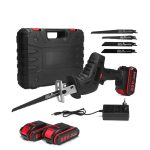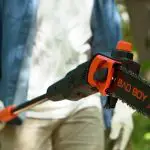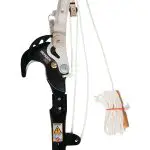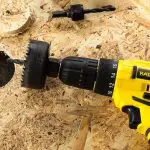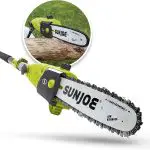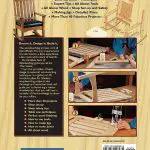To various users, woodworking tools signify different things. To alleviate stress and strengthen creativity, several woodworkers produce effective products. They get value for their expertise in creating high-demand furniture. Regardless of whether you are a skilled woodworker or a complete beginner, you will need the essential woodworking tools. You will get an idea about the woodworking tools list for beginners. We are here to guide you!
Woodworking tools list for beginners – Basic woodworking tools list:
You will find enormous tools available on the market for woodworkers. In our article, we review some woodworking tools that assist you with your projects. Follow the owner’s manual before starting work with them. Let’s take a look-
1. Compound Miter Saw:
Compound miter saws use circular saw blades for making precise cuts. 10 inches and 12 inches are the perfect diameters of the blade though compound miter saws can work with 7 and 12 inches blades. Thus, it cuts any angles effortlessly.
2. Table Saw:
Table saws can make difficult cuts. You will get accuracy by setting the blade depth and angle.
- Cabinet table saws are big and great for everything from lumber ripping to panel cutting.
- Benchtop table saws are portable, making them ideal for storing.
- Contractor table saws are cost-effective and an excellent alternative for beginners.
3. The Sliding Bevel:
A sliding bevel is helpful whether you want to calculate a lot of inclinations. It is flexible, and you can set it at the angle you wish to mark, which helps mark several angles a lot faster.
4. Layout Square:
The layout square marks square cuts. The metal-made layout square is more helpful than a plastic one. Plastic layout squares have a tendency to distort, rendering them worthless.
5. Band saw:
A band saw features a constant, long sharp-toothed blade. It is placed between two or more metal wheels. A band saw is one of the woodworking tools that you should have. It aids cut wood shapes, resawing lumber, and even creating veneers. Blades range from 4 inches to 12 inches. You can know the thickness of the material from it. Wide blades are better for ripping, whereas small blades are better for curved cutting. If you want to get the most out of your machine, make sure you additionally install tires with your bandsaw.
6. Reciprocating Saw:
It gives you the ability to cut through a variety of materials. Simply change the blade and start sawing.
7. Rotary Tool:
You may need rotary tools for a variety of woodworking projects. They are affordable, so you can typically find them under $40 or $50.
8. Router Tool:
It flattens wood or plastic, edge routing, cutting patterns, and cutting dadoes for dado connections.
9. Wood Jointer:
It helps to straighten the board or detach the warp.
10. Wood Moisture Meter:
Do you want to find out how much moisture is in your wood? Purchase a wood moisture meter.
Wood has the ability to contract, distort, and even shatter. Whenever you choose wood with higher moisture content, you may face problems later on when the wood begins to dry and change shape. So, purchase a moisture meter and learn about the minimum moisture content of the woods you’ll be working on.
11. Circular Saw:
If you are a beginner, keep a circular saw in your toolbox. It comes with a sharp-tooth blade that rips through the wood in a round or circular shape. Rip blades cut wood either with regularly spaced teeth. Crosscut blades cut throughout the grain. These blades have dispersed teeth.
12. Safety:
Every business should have precautionary approaches in place. You should know about all safety standards.
Mishaps, breakage, and wood may become airborne. As a result, eye protection is necessary. Whenever you care for your vision, wear protective glasses.
Next, you’ll require earmuffs. Because many power tools produce a high-decibel sound, resulting in tinnitus.
Dust collection is the ultimate safety measure, as dust may penetrate the lungs and reduce its strength.
13. Drawer Slide Jig:
Install a drawer slide jig to glide your drawer slides correctly and freely.
14. Reciprocating Spindle Sander:
When it comes to sanding curves in wood, a reciprocating spindle sander is the most useful instrument.
15. Belt Sanders:
Belt sanders are ideal for removing stock quickly and leveling rough boards.
16. Beam Cutter:
With a beam cutter, you can cut large stockpiles of wood all at once.
17. Chain Mortiser:
A chain mortiser helps you quickly cut mortises into extremely thick wood stocks for long-term home construction.
18. Sawhorses:
It is capable of supporting and balancing lengthy lumber and hefty loads. You can make sturdy sawhorses out of wood, steel, fiberglass, and plastic too. This is a cost-effective approach to recycling discarded materials.
19. Chisels:
Chisels are required by each woodworker to finish joints and saw cuts. Try to buy high-alloy carbon steel chisels or chromium-vanadium alloyed steel chisels.
20. The Shop-Vac:
The Shop-Vac is similar to the household vacuum system. Simply carry a hose, connect it, and the vacuum will do the rest.
Make sure it has adequate amps in the motor. Low amps imply low power and can not do more cleaning with the low power.
21. Workbench:
A workbench enables you to keep your wood in position for cutting and screws to lock it. Nevertheless, constructing a wooden workbench with at least a 3′′ solid tops, strong legs, and one clamp is.
22. Center Scriber:
Visual inspection isn’t always the best option when you require the utmost accuracy and want to execute great work. Then, you can use a center scriber to locate and identify the center of the wood pieces.
23. Multi-Mark Tool:
Squaring, leveling, or shifting measurements are all possible with it.
24. Digital Protractor:
With this digital protractor, you can identify and assess angles. It allows you to create bevel cuts by adjusting the slopes of your table saw, bandsaw, and miter saw blades.
25. Multi-Angle Measuring Ruler:
You can calculate multiple angles, make marks, and replicate patterns using a multi-angle measuring ruler.
26. Claw Hammer:
Nails often create a waffle spot on the wood. A 20 oz claw hammer can help you out.
It can pluck nails with ease. For added comfort, make sure the handles of the hammer have a rubberized surface.
27. Handsaws:
Handsaws are ideal when precise cuts are necessary. They aren’t pricey as well. They consist of a toothed steel blade with a wooden handle to cut wood quickly and accurately.
28. Orbital Sander:
Orbital Sander eliminates the strain associated with hand sanding. It accomplishes this by rotating sandpaper pads in an orbital pattern.
29. Hand Files:
If constructed with high-quality steel, hand files will endure a lot. They normally have coarse teeth. But, it features toothed edges for tight spots.
30. Mallet:
Mallets contain removable handles and wooden or leather heads. They are ideal for tapping wood joints since they create hitting scars.
31. Power Drill:
You can use a power drill for drilling holes. A corded power drill with 110/120 volts is a good choice. They are classified by their chuck size, from 3/8 inches chucks to 1/2 inches chucks.
32. Screw Gun:
With a powered screw gun, you can pull up screws easily. Screw guns are cordless, making them convenient and eliminating the possibility of friction.
33. The Utility Knife:
When scraping mortise joints or scribing wood, the carpenter will use a utility knife.
34. The Rip Fence:
Install a rip fence on your table saw. Several rip fences feature adjustable knobs on both ends, whereas others only offer one.
35. The Screwdriver:
Screwdrivers are an essential woodworking tool. It provides a significant amount of torque. If you want to get deep-holed screws, buy a screwdriver with a small shank. A cabinet screwdriver can also do this work.
36. Nail Set:
It helps to fill up the holes and get them ready to paint. Also, the nail set typically has a surface to prevent nails from falling off and denting the wood.
37. The Clamp:
Clamps are required for 45 and 90-degree joints. Quick clamps are easier to use because they glide into place with one hand. Besides, hand screw clamps are ideal for delivering a lot of force to tapering wood.
There are numerous woodworking tools currently available in the market. These basic woodworking tools lists will not only make you efficient, but they will also make your work pleasant. While processing raw materials into finished products, woodworking tools are used to cut, finish, combine, calibrate, and maintain wooden pieces. They include everything a woodworker will require to construct simple to sophisticated products. Woodworking tools are also helpful in making a variety of shapes. Woodworking tools will allow you to build gorgeous woodwork that will be loved by everyone who sees it.







